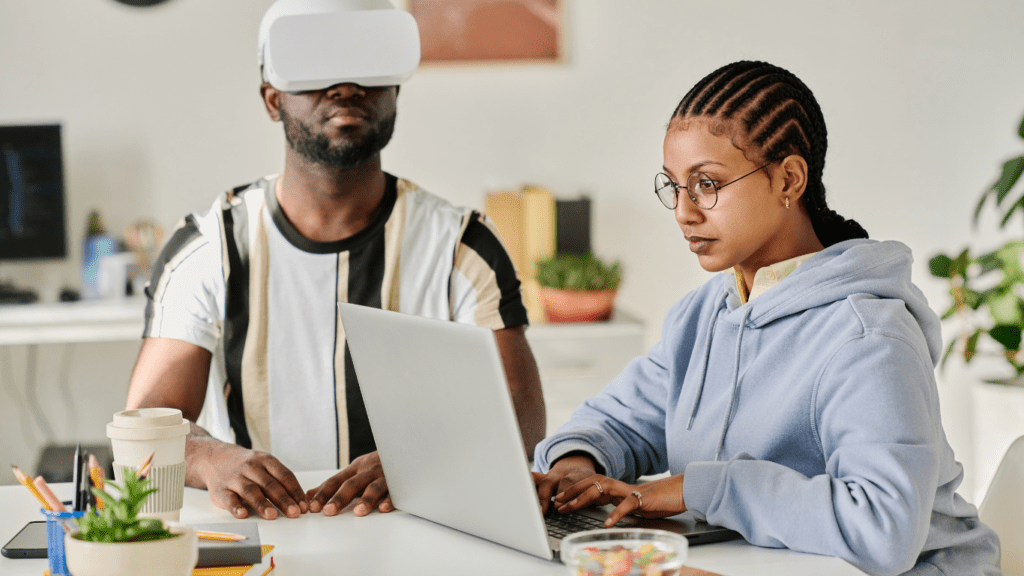Exploring Augmented Reality Art
Augmented Reality (AR) art takes creativity to a new level by fusing physical spaces with digital enhancements. It allows artists to overlay virtual elements onto the real world, creating multidimensional experiences.
What Is Augmented Reality Art?
AR art integrates digital content with the physical environment using devices like smartphones, tablets, and AR glasses.
This genre covers many forms, from virtual sculptures and animated paintings to interactive installations in public spaces. For example, an AR-based mural might display dynamic animations when viewed through a smartphone app, adding layers of meaning and engagement.
History of Augmented Reality in Art
The history of AR in art dates back to the 1990s, beginning with the advent of basic AR technology. Early projects focused on simple overlays and primitive interactions, but as technology evolved, artists explored more complex and immersive experiences. In 1998, artist Julie Martin’s “AR Art Show” introduced many to the potential of this medium.
By the 2010s, augmented reality had become a staple in many exhibitions worldwide. AR’s development has enabled artists to push boundaries and redefine audience interactions with art.
Techniques and Technology Behind Augmented Reality Art

Augmented Reality (AR) art requires a blend of innovative tools and intricate design processes. Here’s an exploration of the essential components and techniques.
Tools Used in Creating AR Art
Artists use various tools to create AR art:
- AR Software Platforms: Programs like Unity, Unreal Engine, and ARKit facilitate the integration of virtual and real-world elements.
- 3D Modeling Software: Artists rely on tools like Blender, Maya, and ZBrush to sculpt virtual objects.
- AR Headsets and Devices: Devices such as Microsoft HoloLens and Magic Leap allow precise integration and display of AR elements.
- Mobile Applications: Apps like Pokémon GO and Adobe Aero enable users to interact with AR art on their smartphones.
The Process of Designing AR Artworks
Creating AR art involves multiple stages:
- Concept Development: Artists brainstorm and sketch ideas, focusing on how virtual elements will coexist with real spaces.
- 3D Modeling and Animation: Artists create detailed 3D models using software, adding textures and animations to bring virtual objects to life.
- Integration with AR Platforms: Using software like Unity, artists integrate 3D models into AR environments, ensuring they interact naturally with real-world settings.
- Testing and Iteration: Artists test AR experiences across different devices and environments, making adjustments to optimize performance and user engagement.
- Deployment: Once finalized, AR art is made accessible through galleries, public spaces, or digital platforms, allowing audience interaction.
Mastering these techniques empowers artists to create captivating, immersive AR artworks that blend the virtual with the real seamlessly.
Notable Augmented Reality Art Projects
Augmented Reality art has provided numerous engaging experiences by blending virtual and real-world elements seamlessly. Let’s explore some renowned projects that illustrate the potential of AR art.
Public Installations and Exhibitions
Innovative artists have showcased AR in public spaces, transforming traditional exhibitions.
- The Unreal Garden: Created by Onedome, this interactive experience in San Francisco combines AR with physical environments. It features digital flora and fauna that visitors can interact with via AR headsets, enhancing sensory engagement.
- Buenos Aires International Festival of Contemporary Art: This festival incorporated AR to augment traditional artworks. Artists like Nancy Baker Cahill presented pieces, allowing users to view dynamic overlays on their devices, providing a new dimension to static art.
Interactive AR Art Experiences
Interactive AR art projects offer users immersive experiences by integrating virtual components with physical interaction.
- ARTivive App Projects: ARTivive is an AR platform that artists use to overlay animations onto physical artworks. For instance, murals by artist Shamsia Hassani come to life, telling stories beyond static images when viewed through the ARTivive app.
- Acute Art: This platform collaborates with artists like Koo Jeong A and Anish Kapoor to create AR sculptures viewable via mobile devices. Users can place these digital installations in any environment, merging virtual art with their surroundings for a unique experience.
These AR art projects exemplify the intersection of cutting-edge technology and artistic innovation, pushing the boundaries of how we perceive and experience art.
Impacts of Augmented Reality on the Art World
Augmented Reality (AR) revolutionizes the art world, blending the real and virtual. It reshapes artistic expression, production, and audience engagement.
Changes in Artistic Expression and Production
AR transforms artistic expression by enabling artists to merge digital elements with physical artwork. This integration creates multidimensional art pieces, rendering static art forms dynamic and interactive.
For instance, artists using AR overlay animations or 3D models on traditional canvases or sculptures, enriching the viewer’s experience.
Production processes evolve with AR tools, offering artists new mediums to experiment with digital and virtual techniques.
Artists design virtual layers that interact with physical space, such as projecting videos or audio elements through AR apps. Consequently, the boundaries of artistic creativity expand, with hybrid works fusing traditional and contemporary methods.
Audience Engagement and Accessibility
AR enhances audience engagement by creating immersive and interactive art experiences. Viewers engage with art in innovative ways, such as through AR-enabled apps that reveal hidden layers or narratives within the artwork. For example, platforms like ARTivive allow users to scan artworks with their smartphones, unlocking additional digital content.
Accessibility improves as AR brings art experiences to wider audiences. Virtual exhibitions and AR installations eliminate geographical barriers, allowing global viewers to access art from anywhere.
Additionally, AR makes art more inclusive for individuals with disabilities by offering customizable and sensory-rich experiences, improving participation and appreciation of art across diverse demographics.
Future Trends in Augmented Reality Art
Emerging trends in augmented reality (AR) art promise to further blend the lines between the real and virtual worlds. These developments are set to revolutionize artistic experiences and push creative boundaries.
Innovations on the Horizon
Technological advancements will drive the future of AR art. AI integration allows for real-time interaction. For instance, AI can modify elements of the art based on viewer emotions.
Enhanced AR glasses will offer more seamless and immersive experiences, eliminating the need for handheld devices. Blockchain ensures art authentication and provenance, giving digital art a secure space. Holoride and other 5G enhancements will enable faster, more interactive experiences, amplifying user engagement.
Challenges and Opportunities for Artists
Artists face technical and conceptual challenges. Mastering AR technologies requires new skills. However, overcoming these challenges presents opportunities. Expanding digital skill sets offers artists new creative tools.
The inclusivity of AR art democratizes access and allows global audiences to engage without physical constraints. Revenue models shift with AR, as artists can sell virtual pieces, offer immersive experiences, and license digital overlays, broadening commercial prospects.


